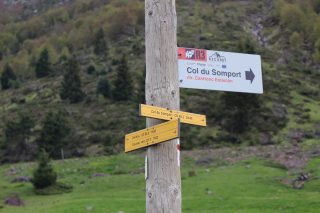Honors College Fellow Jacob Honeycutt, a history, anthropology and international studies triple major, follows in the footsteps of Roman traders and medieval pilgrims on a hike up to the Somport Pass in the Pyrenees.
All throughout our first week on Honors Passport: Pilgrimage, there was talk of the upcoming Herculean hike on the Camino de Santiago that was to take place over the Pyrenees mountains. It was rumoured that there would be an option to hike nine miles, an option to hike three miles, and and option to not hike. Fellow students debated whether to hike nine or three miles, and after deciding that I would regret not doing all nine, I decided to hike nine miles. Nothing, though, could have prepared me for what was to come.
At around noon, after a long bus ride from Toulouse, we arrived at a small town deep in the French Pyrenees called Urdos. The scenery from here was already amazing. On the drive up to Urdos, there was a babbling brook that was running fresh out of the mountains, and in front of us were enormous snow-capped mountains. While in Urdos, we ate a delicious lunch of steak and fries that a hotel there had prepared for us, and then we met our guides and were ready to hike the Camino over the Pyrenees.
On the way up to the hike, our guides told us that the Camino route that we were to be hiking was first established as a Roman trading route to Toulouse, as the Romans had found the pass there through the mountains. So as we began our hike, I looked around and thought about what it must have been like for Roman traders to have walked on that exact same narrow dirt path through those calm woods. Whether the Roman traders had come from somewhere in Hispania such as Barcelona, or had come all the way from Rome, it would have already been a long, largely mundane walk, and walking through this forest with the tall Pyrenees mountains visible on the right must have been an incredible and somewhat relaxing experience. Also, at this point, there was a road to our right and old abandoned railroad tracks as well, and those clearly would not have been there when the Roman traders walked through. The three paths next to each other were an aesthetic juxtaposition of the classical period, the 19th century, and the 20th century in one view.
Further down the trail, after we had climbed thousands of feet and walked alongside cliffs and mud, we came to a pasture area where there were ruins of a very old building to our left. Our guides stopped us here and explained that these were the ruins of a eleventh or twelfth century hospital for pilgrims. At that time, hospital did not mean what it means today, but meant more that this place was a refuge and a shelter where pilgrims could stop. I imagined then what it would have been like to be a pilgrim on the Camino de Santiago walking this path in the Middle Ages. A pilgrim would have already walked many days by the time they reached this point, and this hike over the Pyrenees would have been the most dangerous yet. After climbing thousands of feet, this refuge would have been a welcome sight to see for the pilgrims who made it this far.

The trail was well-marked but we were glad to have guides. They shared a lot of interesting history about the Via Tolusa.
After these old ruins, we climbed a hill and then crossed a road, and on the other side of the road was the rest of our group who had elected to only hike the last few miles. Right as we were meeting up with this group, we all looked back and saw dark rain clouds – an ominous sign. As rain had been predicted as a possibility, I had a poncho jacket with me in my backpack so that I would not get too wet. During the first half of the last part of our hike, it only sprinkled, and that level of rain was actually enjoyable. Hoever, halfway into this part of the hike, one of our tour guides told us it would now start heavily raining, and he was right – the rain came down in force.

Ponchos and umbrellas couldn’t ward off this weather –– but the last sprint up the mountain was an exhilarating experience.
The rain was so heavy that my poncho soaked part of the way through, and everyone’s shoes got significantly wet. Finally, we climbed one last steep hill, and we arrived at a parking lot off of where the road marked the border between France and Spain, a place called Somport Peak.
Reaching the top, six thousand feet above sea level, was an exhilarating experience. I hopped back onto the bus sopping wet, but I felt like I had had the greatest experience yet on this trip. I conquered the Pyrenees, and walked where thousands of people, ranging from Romans to medieval hikers, have preceded me on the Camino de Santiago.


